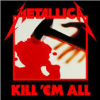Liverpool Sound and Vision Rating * * *
For many it was the album that was the beginning of Thrash Metal. The next logical step from Heavy Metal that found its way from America as in an exuberant recognition that British Heavy Metal had stolen a march on the genre. Metallica’s Kill ‘Em All certainly stands out as being part of the genre but it’s overall feel 30 years after its release is more of being the partially formed conception, the gestation period before the moment of truth with Metallica’s Ride The Lightning coming in 1984 and the genre exploding in its classic era between 1985 and 1992 when bands such as Sacred Reich, Megadeth, Slayer, Anthrax easily stood head and shoulders above anything coming out of continental Europe and in some respects the U.K.
The classic line-up that would dominate the genre for the next few years had not long come together by the time the album had been unleashed, with Kirk Hammett’s lead guitar coming into replace Dave Mustaine who had been fired in the April. The resulting album, the debut by the band, showed exactly what the genre could achieve given time. On its own and taken out of the discography, it is an album that speeds along as if travelling in a top of the range Lamborghini on a busy motorway but stuck persistently between third and fourth gear, it’s exciting but not quite what you would expect or hope the performance to be. That is right until the fourth side on the original vinyl when that initial conception suddenly shows signs of going into the labour of birth and the proud parents starting to think of names, the song that really frames the beginning, Seek and Destroy.
As a collective though, thrust firmly once more into the whole discography, it’s a good start. It’s not perfect, very few Metal albums have that honour, however in terms of value to Metallica history it really is a great start and leads perfectly towards Ride The Lightning and Master Of Puppets. The energy throughout is intoxicatingly brutal, for those who for many years had the renaissance of British Heavy Metal, this was new, this was a ten tonne truck leaking oil and throwing a lighted match over what Britain and Europe was enjoying.
The songs that appear on the album are standard metal fare, with the exception of Seek and Destroy and perhaps to a lesser extent Whiplash. Both tracks play on the fire, they garnish the genre with the sound of destruction, of wanton music obliteration and throughout it all the listener cannot help but feel sorry for the world of Metal. With this new subsection of the genre on the cusp of dominating Metal for a decade, the splits between fans would start to show. Whereas at one time Metal was just that, just great lyrics rolled up in a ball of steel and with a casing of iron thrown around it and several million guards with itchy trigger fingers just waiting for anybody to start having a go at their beloved music. Now with the splitting of the genre into a subsection, something that would happen more and more over the coming two decades, the guardians of the music could feel a division coming on. Whilst the music would be undoubtedly be superb, thrilling and needed, it would pitch fan against fan if they weren’t careful.
Seek And Destroy is perhaps arguably the best track on the album and one that can sit so comfortably within the whole range of the Metallica discography and in some cases between 1993 and 2008 would actually enhance the albums. It is a blistering track that defies the age and in rock clubs up and down the U.K. years after its release would still be much called for. In the Heavy Metal heartland of Birmingham, the American band’s track was such a hit that in the city’s two premier rock clubs at the time, Eddie’s and Costermongers, it was almost unheard for the track not to be played every week when the rock D.J.’s were in the venue. If fans in Birmingham and the Midlands, the traditional home of Metal, were warming to this new interloper from across the Atlantic then what was to come in the next decade could only be described as a phenomenon.
Kill ‘Em All lays the foundations for Thrash Metal to become the heart-beat of Metal for the next ten years and even now it is still praised when done right. The bands that started it off never quite disappearing, Megadeth, Metallica, Slayer and Anthrax, the so-called big four, all performed to huge crowds at Sonisphere in 2012. Proof that Thrash Metal was needed by a generation that liked their Metal but desired it to be faster, bigger, brighter and more out of control than the bands had been performing since 1970 were capable of doing.
Ian D. Hall
